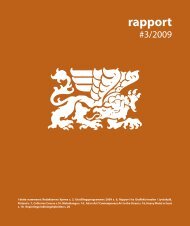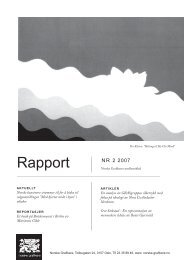Rapport nr. 3+4 2010-straight.indd - Norske Grafikere
Rapport nr. 3+4 2010-straight.indd - Norske Grafikere
Rapport nr. 3+4 2010-straight.indd - Norske Grafikere
You also want an ePaper? Increase the reach of your titles
YUMPU automatically turns print PDFs into web optimized ePapers that Google loves.
Representing Artists´ Books<br />
by Kasia Wlaszyk<br />
Looking at the form of the book as an art asserting its own ground in the gallery space, this article<br />
examines the foundations of KALEID editions, London’s only gallery dedicated to artists’ books and its future<br />
development of site specific projects.<br />
Platonic, Louise Bristow<br />
art. Being fully aware of this condition,<br />
the project space engaged visitors with<br />
artists’ books by removing any presence<br />
of vitrines or shelves and allowed people<br />
to handle display pieces, inviting an<br />
interactive experience with contemporary<br />
art.<br />
The practice of artists’ books is one of<br />
prolific output that has rarely attracted<br />
the equivalent representation. We know<br />
of artists (such as Ed Ruscha) who<br />
have made artists’ books, yet galleries<br />
and their extended forms of discourse<br />
seldom support this practice as an<br />
autonomous art form. It is hard to think<br />
of artists’ books without thinking of<br />
books about artists, and it is this lack<br />
of self-definition that inspired the artist<br />
Victoria Browne to develop a project<br />
space to focus on representation, and<br />
introduce a new audience to ‘artists who<br />
do books’.<br />
Browne studied her MA at the University<br />
of the West of England’s Centre for<br />
Print and Artists’ Books Research, part<br />
of which was completed in Marseille,<br />
enabling her to visit Atelier Vis-à-Vis,<br />
to work with Kilometer Zero, and travel<br />
to Florence Loewy in Paris. Browne<br />
returned to London in 2005 to work for<br />
Bookartbookshop before running East<br />
London Printmakers in London Fields,<br />
Hackney. In 2009 she curated Kaleid a<br />
group exhibition of fellow Middlesex<br />
University artists in residence at Martin<br />
Sexton’s Art Wars project space on<br />
Redchurch Street, London.<br />
Shoreditch as a East End Mecca for<br />
contemporary art galleries, media arts and<br />
fashion, proved an eclectic environment<br />
and the perfect background for Browne’s<br />
continued foray into artists’ books. In<br />
August 2009 KALEID editions was<br />
founded adjacent to Art Wars. And with<br />
a month to renovate and install, opened<br />
with Our Worlds Collided an exhibition<br />
by emerging artist and home-grown Eastender<br />
Leigh Clarke. A graduate from the<br />
Royal College of Art, Clarke’s large scale<br />
paintings and video shown alongside his<br />
artist’s book was a brash oeuvre and a well<br />
received show to the development of the<br />
project’s context.<br />
Realising the challenge of sustaining a<br />
gallery space with consecutive artists,<br />
a rolling programme of solo, dual and<br />
group shows quickly emerged, reflecting<br />
the potential diversity in the practice.<br />
KALEID also sourced small publishers,<br />
and by visiting an art distributor in<br />
person, Browne was able to choose books<br />
that related to the space and its thematic;<br />
including Anthony D’Offay publications<br />
of Joseph Beuys, Kiki Smith and Francesco<br />
Clemente and Hanover Gallery’s Eduardo<br />
Paolozzi. The carefully compiled archive<br />
extended KALEID into both a space for<br />
exhibiting the artistic practice as well as<br />
a space for representing contemporary<br />
artists’ books in a theoretical and therefore<br />
academic discourse.<br />
In October <strong>2010</strong>, Alex Hamilton exhibited<br />
large scale pen and graphite works on<br />
paper. His ice-trumpet performance<br />
Arches and Seizures, projected onto the<br />
ceiling, was the inspiration for his artist’s<br />
book of the same name, a fascimile posterbook<br />
on archival paper. The permission to<br />
show an artist already represented by the<br />
London gallery Patrick Heide reaffirmed<br />
Browne’s conviction of artists’ books as<br />
an under-represented ge<strong>nr</strong>e and one that<br />
could be autonomous as a catalyst without<br />
being limited to the artist’s own practice.<br />
Exhibiting artists included Peter Rapp<br />
and Nick Morley, a dual show of etchings,<br />
screenprints, linocuts and drawings was<br />
followed by a group show Grand Plasto-<br />
Baader-Books, a dizzying arrangement of<br />
unique pieces, highlighting the possibility<br />
of artists’ books not only an editioned<br />
practice but also one of a singular narrative.<br />
Owen Bullett and Louise Bristow’s<br />
maquettes, sculptures and paintings,<br />
preceded Jonathan Ward’s solo show (the<br />
only book-artist invited to the space) and<br />
a season of performance art by Sheila<br />
Ghelani, Helen Shoene, Francis Elliott<br />
and Jordan McKenzie. Annette Habel’s<br />
pinhole portrait photographs and Fraser<br />
Muggeridge Studio’s designed books<br />
meticulously deconstructed by Samantha<br />
Huang. Browne’s nocturnal exterior wall<br />
projection complemented Katherine’s<br />
Jones interior mobile installation, followed<br />
by the second group show White Heat and<br />
an archive collection of artists’ books from<br />
the Frans Masereel Centre in Belgium<br />
featuring Colin Waeghe’s paintings, and<br />
finally a group show of MA Book Arts<br />
graduates from Camberwell College of<br />
Arts, the University of the Arts London.<br />
In the Post-Modern perception, the<br />
physicality of a gallery space is inherently<br />
scarred with connotations. It is unable<br />
to rid itself of subjectivity and achieve a<br />
utopian and objective representation of<br />
KALEID adopted a sympathetic design<br />
to the space; objects which in themselves<br />
could be considered as pieces of art.<br />
Swedish designer Lars Frideen’s bespoke<br />
modular display unit could<br />
accommodate the small press<br />
publications. Lighting the work, a major<br />
factor of any gallery, was constructed<br />
from copper piping by Lee Holden, a<br />
video and sculpture artist. Finally, in the<br />
centre of the gallery, an original roulette<br />
table on loan from Vivienne Westwood’s<br />
interior designer was reupholstered in<br />
rubber used on a catwalk in the Louvre.<br />
This functioned as a surface to exhibit<br />
sculptural books and quickly became the<br />
main identity of the project. The unique<br />
gallery hosted a multi-chromatic range<br />
of exhibitions, simultaneously upholding<br />
the clean aesthetics though without<br />
transforming it into another white space.<br />
Constantly engaging an audience at a<br />
permanent location, KALEID editions<br />
developed a multiplicity of artist led<br />
activities, participatory events, book<br />
launches, FLASH reviews and publications.<br />
This established a heterogeneous and<br />
Galling Moments ,Jonathan Ward<br />
42<br />
43





